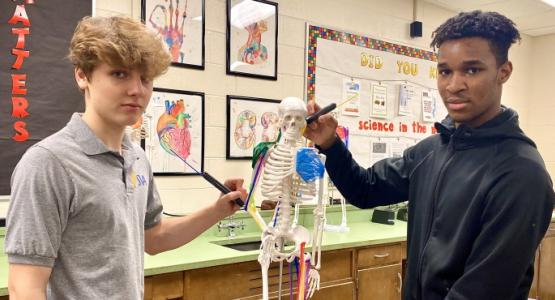
Spring Valley Academy Launches New Course, Implements 3-D Pens
Story by Aaron Knowlton, Grades 7 - 12 Science Teacher
Anatomy and Physiology (A&P) is Spring Valley Academy’s (SVA) new advanced life science elective course for grades 11 and 12. It is designed to expand students’ knowledge of the structure and function of the human body. As the instructor, it is my desire that, while studying the complexities of the human body, students develop a better understanding of their Creator and a deeper appreciation of His handiwork within each of them! I want my students to know how wonderfully they are made.
One goal of our A&P class is to take challenging topics and make them memorable—not just to learn the topics and not practice or experience them. This is one reason I incorporated 3-D pens into my class. Awhile back, I was introduced to the concept of using 3-D printing pens by a professor at Sage College (N.Y.). Immediately, I knew this was something we could incorporate into SVA’s lab instruction.
Junior Vivian Reeves, who desires to become a gastroenterologist, shares, “I like being able to be creative using a fun way of learning. I was able to visually take mental images of the proper locations of muscles.” Senior Giselle Linares adds, “The advantages of using the 3-D technology is that it gives you a more realistic version of what you are studying. ... It helps you to visualize better how the muscles work.”
Each year, my students are asked to memorize many muscles. However, what tends to be most challenging is the learning of the origin and insertion of these muscles. Now, instead of memorizing muscle insertion and origins from a 2-D diagram, our students use 3-D printing pens to print muscles on skeletons.
“Using the 3-D pens really helped me memorize the muscle origins and insertions, and I was able to better understand the muscular system by being hands-on with the 3-D pens learning in a more engaging and creative way,” states senior Logan Morrison.
Using skeletons allows the students to accurately anchor each muscle at the appropriate bone process or depression—something paper cannot do. Students are also able to see firsthand how each muscle directly articulates the bones of each body part. Implementing the 3-D pens to learn muscle origins and insertions has greatly increased student engagement and has drastically improved their level of understanding. In fact, on several occasions, I had students coming after school to ask if they could print more muscles!

Add new comment